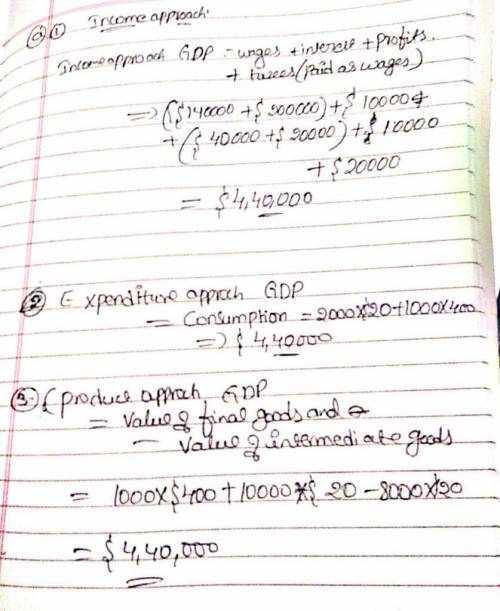Consider an economy with two firms and a government.
Firm 1 produces 10000 units of good...

Business, 10.03.2020 22:34 jadenicole908
Consider an economy with two firms and a government.
Firm 1 produces 10000 units of good X, which it sells for $20 per unit. It uses this revenue to pay $140000 in wages, $10000 in taxes, and $10000 in interest on a loan, with the rest as profits. Firm 1 sells some of its output to consumers, and some to
Firm 2 as an intermediate good in their production process. Firm 2 uses good X as an input into its manufacturing process. It buys 8000 units of good X and uses them to create 1000 units of good Y, which it sells for $400 per unit. It pays $200000 in wages and $20000 in taxes, with the rest as profits.
The government takes in taxes from only these two firms, and uses it to pay wages to provide government services, for instance national defense.
b) A foreign competitor enters the market for good X. Consumers and firm 2 still consume the same level of good X; however, Firm 1 now only produces 8000 units of good X, with the foreign firm selling 2000 units of good X (1000 to consumers and 1000 to Firm 2). Firm 1 pays the same wages and taxes as it did when it sold 10 000 units of good X.
Question: It is discovered that this "foreign" firm is actually owned by Firm 1, but is located outside of the country. Re-calculate GDP (gross domestic product) from part (b). What, if anything, does this tell you about the difference between GDP and GNP?

Answers: 2


Another question on Business

Business, 21.06.2019 21:30
Recently, verizon wireless ran a pricing trial in order to estimate the elasticity of demand for its services. the manager selected three states that were representative of its entire service area and increased prices by 5 percent to customers in those areas. one week later, the number of customers enrolled in verizon's cellular plans declined 4 percent in those states, while enrollments in states where prices were not increased remained flat. the manager used this information to estimate the own-price elasticity of demand and, based on her findings, immediately increased prices in all market areas by 5 percent in an attempt to boost the company's 2016 annual revenues. one year later, the manager was perplexed because verizon's 2016 annual revenues were 10 percent lower than those in 2015"the price increase apparently led to a reduction in the company's revenues. did the manager make an error? yes - the one-week measures show demand is inelastic, so a price increase will decrease revenues. yes - the one-week measures show demand is elastic, so a price increase will reduce revenues. yes - cell phone elasticity is likely much larger in the long-run than the short-run. no - the cell phone market must have changed between 2011 and 2012 for this price increase to lower revenues.
Answers: 3

Business, 22.06.2019 16:00
If the family’s net monthly income is 7,800 what percent of the income is spent on food clothing and housing?
Answers: 3

Business, 22.06.2019 16:40
An electronics store is running a promotion where for every video game purchased, the customer receives a coupon upon checkout to purchase a second game at a 50% discount. the coupons expire in one year. the store normally recognized a gross profit margin of 40% of the selling price on video games. how would the store account for a purchase using the discount coupon?
Answers: 3

Business, 23.06.2019 06:30
Afinance company wants to upgrade its accounting software to a higher version. this version change requires a change in data formats. which method represents a change in data formats?
Answers: 1
You know the right answer?
Questions


History, 14.01.2021 04:50

Mathematics, 14.01.2021 04:50


Arts, 14.01.2021 04:50

Arts, 14.01.2021 04:50

English, 14.01.2021 04:50

Mathematics, 14.01.2021 04:50

English, 14.01.2021 04:50

Mathematics, 14.01.2021 04:50

Mathematics, 14.01.2021 04:50

Mathematics, 14.01.2021 04:50

Mathematics, 14.01.2021 04:50


Mathematics, 14.01.2021 04:50


Mathematics, 14.01.2021 04:50


Mathematics, 14.01.2021 04:50

English, 14.01.2021 04:50




